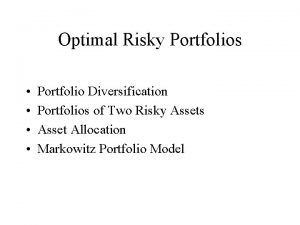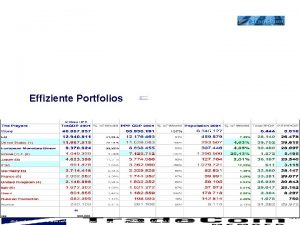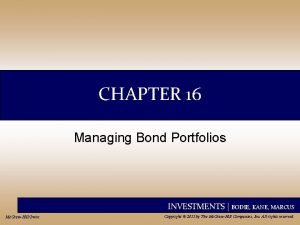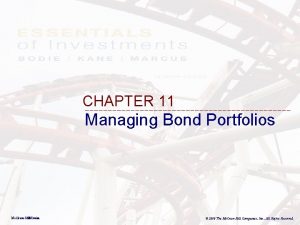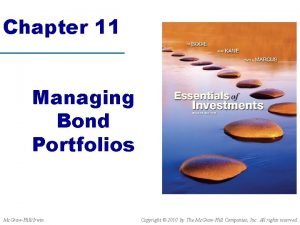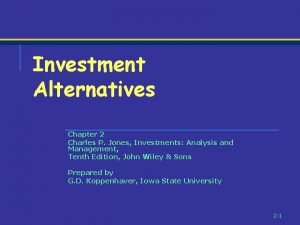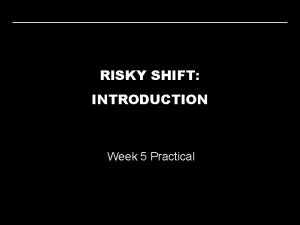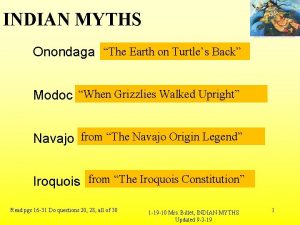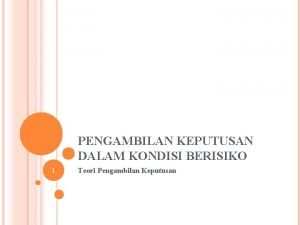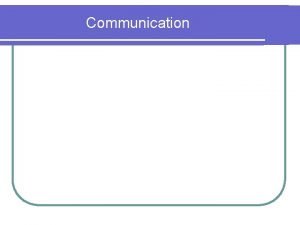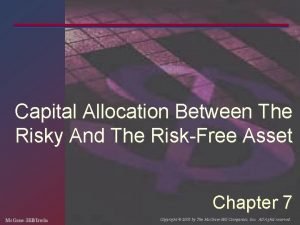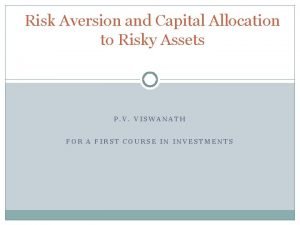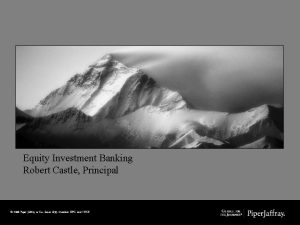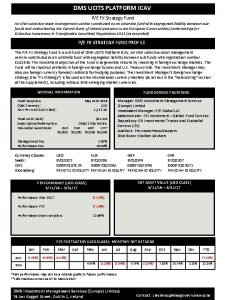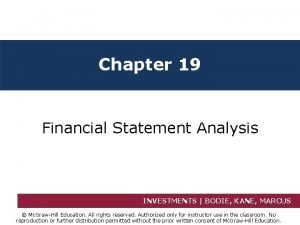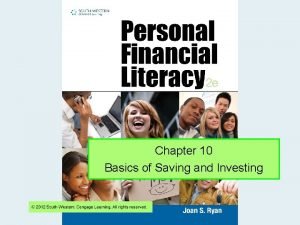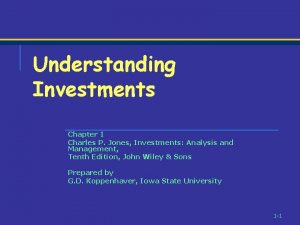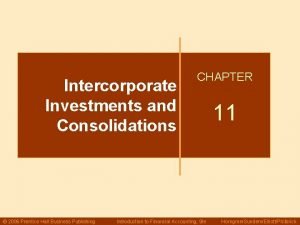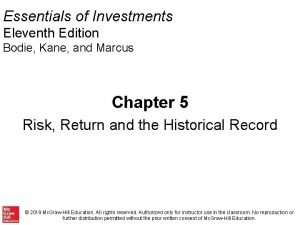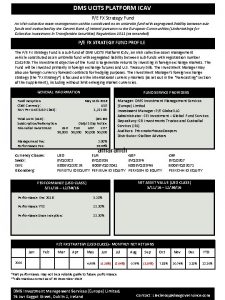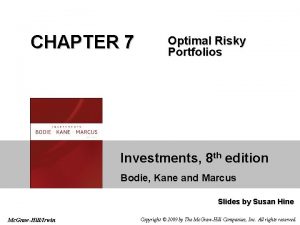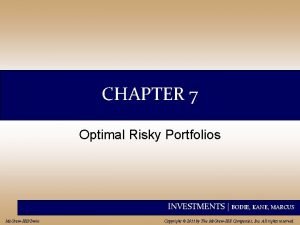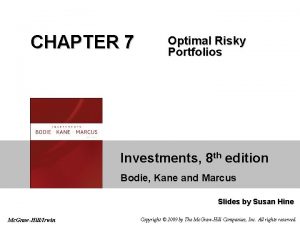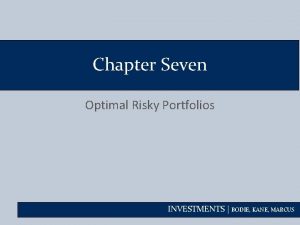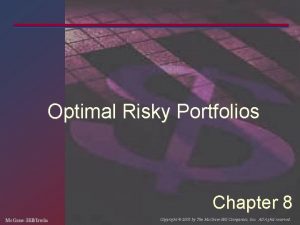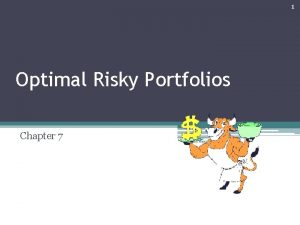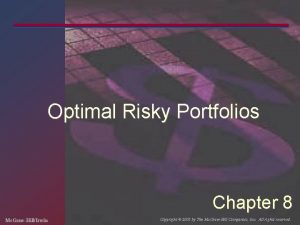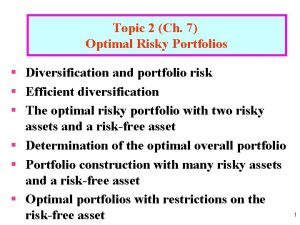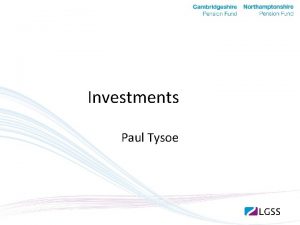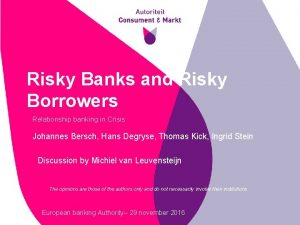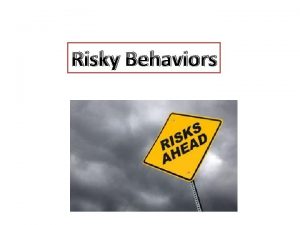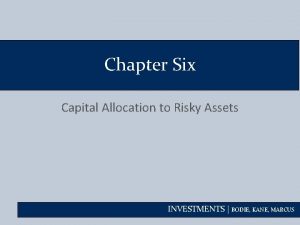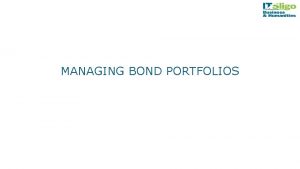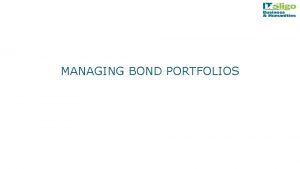7 1 CHAPTER 7 Optimal Risky Portfolios INVESTMENTS






































- Slides: 38

7 -1 CHAPTER 7 Optimal Risky Portfolios INVESTMENTS | BODIE, KANE, MARCUS Mc. Graw-Hill/Irwin Copyright © 2011 by The Mc. Graw-Hill Companies, Inc. All rights reserved.

7 -2 The Investment Decision • Top-down process with 3 steps: 1. Capital allocation between the risky portfolio and risk-free asset 2. Asset allocation across broad asset classes 3. Security selection of individual assets within each asset class INVESTMENTS | BODIE, KANE, MARCUS

7 -3 Diversification and Portfolio Risk • Market risk – Systematic or nondiversifiable • Firm-specific risk – Diversifiable or nonsystematic INVESTMENTS | BODIE, KANE, MARCUS

7 -4 Figure 7. 1 Portfolio Risk as a Function of the Number of Stocks in the Portfolio INVESTMENTS | BODIE, KANE, MARCUS

7 -5 Figure 7. 2 Portfolio Diversification INVESTMENTS | BODIE, KANE, MARCUS

7 -6 Covariance and Correlation • Portfolio risk depends on the correlation between the returns of the assets in the portfolio • Covariance and the correlation coefficient provide a measure of the way returns of two assets vary INVESTMENTS | BODIE, KANE, MARCUS

7 -7 Two-Security Portfolio: Return INVESTMENTS | BODIE, KANE, MARCUS

7 -8 Two-Security Portfolio: Risk = Variance of Security D = Variance of Security E = Covariance of returns for Security D and Security E INVESTMENTS | BODIE, KANE, MARCUS

7 -9 Two-Security Portfolio: Risk • Another way to express variance of the portfolio: INVESTMENTS | BODIE, KANE, MARCUS

7 -10 Covariance Cov(r. D, r. E) = DE D E D, E = Correlation coefficient of returns D = Standard deviation of returns for Security D E = Standard deviation of returns for Security E INVESTMENTS | BODIE, KANE, MARCUS

7 -11 Correlation Coefficients: Possible Values Range of values for 1, 2 + 1. 0 > > -1. 0 If = 1. 0, the securities are perfectly positively correlated If = - 1. 0, the securities are perfectly negatively correlated INVESTMENTS | BODIE, KANE, MARCUS

7 -12 Correlation Coefficients • When ρDE = 1, there is no diversification • When ρDE = -1, a perfect hedge is possible INVESTMENTS | BODIE, KANE, MARCUS

7 -13 Table 7. 2 Computation of Portfolio Variance From the Covariance Matrix INVESTMENTS | BODIE, KANE, MARCUS

7 -14 Three-Asset Portfolio INVESTMENTS | BODIE, KANE, MARCUS

7 -15 Figure 7. 3 Portfolio Expected Return as a Function of Investment Proportions INVESTMENTS | BODIE, KANE, MARCUS

7 -16 Figure 7. 4 Portfolio Standard Deviation as a Function of Investment Proportions INVESTMENTS | BODIE, KANE, MARCUS

7 -17 The Minimum Variance Portfolio • The minimum variance portfolio is the portfolio composed of the risky assets that has the smallest standard deviation, the portfolio with least risk. • When correlation is less than +1, the portfolio standard deviation may be smaller than that of either of the individual component assets. • When correlation is -1, the standard deviation of the minimum variance portfolio is zero. INVESTMENTS | BODIE, KANE, MARCUS

7 -18 Figure 7. 5 Portfolio Expected Return as a Function of Standard Deviation INVESTMENTS | BODIE, KANE, MARCUS

7 -19 Correlation Effects • The amount of possible risk reduction through diversification depends on the correlation. • The risk reduction potential increases as the correlation approaches -1. – If r = +1. 0, no risk reduction is possible. – If r = 0, σP may be less than the standard deviation of either component asset. – If r = -1. 0, a riskless hedge is possible. INVESTMENTS | BODIE, KANE, MARCUS

7 -20 Figure 7. 6 The Opportunity Set of the Debt and Equity Funds and Two Feasible CALs INVESTMENTS | BODIE, KANE, MARCUS

7 -21 The Sharpe Ratio • Maximize the slope of the CAL for any possible portfolio, P. • The objective function is the slope: • The slope is also the Sharpe ratio. INVESTMENTS | BODIE, KANE, MARCUS

7 -22 Figure 7. 7 The Opportunity Set of the Debt and Equity Funds with the Optimal CAL and the Optimal Risky Portfolio INVESTMENTS | BODIE, KANE, MARCUS

7 -23 Figure 7. 8 Determination of the Optimal Overall Portfolio INVESTMENTS | BODIE, KANE, MARCUS

7 -24 Figure 7. 9 The Proportions of the Optimal Overall Portfolio INVESTMENTS | BODIE, KANE, MARCUS

7 -25 Markowitz Portfolio Selection Model • Security Selection – The first step is to determine the riskreturn opportunities available. – All portfolios that lie on the minimumvariance frontier from the global minimum-variance portfolio and upward provide the best risk-return combinations INVESTMENTS | BODIE, KANE, MARCUS

7 -26 Figure 7. 10 The Minimum-Variance Frontier of Risky Assets INVESTMENTS | BODIE, KANE, MARCUS

7 -27 Markowitz Portfolio Selection Model • We now search for the CAL with the highest reward-to-variability ratio INVESTMENTS | BODIE, KANE, MARCUS

7 -28 Figure 7. 11 The Efficient Frontier of Risky Assets with the Optimal CAL INVESTMENTS | BODIE, KANE, MARCUS

7 -29 Markowitz Portfolio Selection Model • Everyone invests in P, regardless of their degree of risk aversion. – More risk averse investors put more in the risk -free asset. – Less risk averse investors put more in P. INVESTMENTS | BODIE, KANE, MARCUS

Capital Allocation and the Separation Property 7 -30 • The separation property tells us that the portfolio choice problem may be separated into two independent tasks – Determination of the optimal risky portfolio is purely technical. – Allocation of the complete portfolio to Tbills versus the risky portfolio depends on personal preference. INVESTMENTS | BODIE, KANE, MARCUS

7 -31 Figure 7. 13 Capital Allocation Lines with Various Portfolios from the Efficient Set INVESTMENTS | BODIE, KANE, MARCUS

7 -32 The Power of Diversification • Remember: • If we define the average variance and average covariance of the securities as: INVESTMENTS | BODIE, KANE, MARCUS

7 -33 The Power of Diversification • We can then express portfolio variance as: INVESTMENTS | BODIE, KANE, MARCUS

7 -34 Table 7. 4 Risk Reduction of Equally Weighted Portfolios in Correlated and Uncorrelated Universes INVESTMENTS | BODIE, KANE, MARCUS

Optimal Portfolios and Nonnormal Returns 7 -35 • Fat-tailed distributions can result in extreme values of Va. R and ES and encourage smaller allocations to the risky portfolio. • If other portfolios provide sufficiently better Va. R and ES values than the mean-variance efficient portfolio, we may prefer these when faced with fat-tailed distributions. INVESTMENTS | BODIE, KANE, MARCUS

7 -36 Risk Pooling and the Insurance Principle • Risk pooling: merging uncorrelated, risky projects as a means to reduce risk. – increases the scale of the risky investment by adding additional uncorrelated assets. • The insurance principle: risk increases less than proportionally to the number of policies insured when the policies are uncorrelated – Sharpe ratio increases INVESTMENTS | BODIE, KANE, MARCUS

7 -37 Risk Sharing • As risky assets are added to the portfolio, a portion of the pool is sold to maintain a risky portfolio of fixed size. • Risk sharing combined with risk pooling is the key to the insurance industry. • True diversification means spreading a portfolio of fixed size across many assets, not merely adding more risky bets to an ever-growing risky portfolio. INVESTMENTS | BODIE, KANE, MARCUS

7 -38 Investment for the Long Run Long Term Strategy Short Term Strategy • Invest in the risky portfolio for 2 years. • Invest in the risky portfolio for 1 year and in the risk-free asset for the second year. – Long-term strategy is riskier. – Risk can be reduced by selling some of the risky assets in year 2. – “Time diversification” is not true diversification. INVESTMENTS | BODIE, KANE, MARCUS
 Optimal complete portfolio formula
Optimal complete portfolio formula Activity sheet 2: stock market calculations
Activity sheet 2: stock market calculations Effizientes portfolio
Effizientes portfolio Managing bond portfolios
Managing bond portfolios Managing bond portfolios
Managing bond portfolios Managing bond portfolios
Managing bond portfolios Chapter 17 intermediate accounting
Chapter 17 intermediate accounting Under ifrs the presumption is that equity investments are
Under ifrs the presumption is that equity investments are Chapter 2 investments
Chapter 2 investments Chapter 11 real estate and other investments
Chapter 11 real estate and other investments Risky mosiac
Risky mosiac Risky shift example
Risky shift example Muskrat makes a risky and desperate swim
Muskrat makes a risky and desperate swim Risky adventure sports
Risky adventure sports Risky curves clothing
Risky curves clothing Pengertian pengambilan keputusan dalam kondisi beresiko
Pengertian pengambilan keputusan dalam kondisi beresiko Risky behaviour defination
Risky behaviour defination Capital allocation between risky and risk free asset
Capital allocation between risky and risk free asset Lab – discover your own risky online behavior
Lab – discover your own risky online behavior Risky sports
Risky sports What shape is the utility of a risk-averse investor?
What shape is the utility of a risk-averse investor? Equity method vs cost method
Equity method vs cost method Fundamentals of analyzing real estate investments download
Fundamentals of analyzing real estate investments download Investments bkm
Investments bkm Investments bodie kane marcus
Investments bodie kane marcus Loarre investments
Loarre investments Dms strategie consulting
Dms strategie consulting More power investments
More power investments Investments bodie kane marcus summary
Investments bodie kane marcus summary Holding a variety of investments to reduce risk
Holding a variety of investments to reduce risk Manulife bank investment loan
Manulife bank investment loan Investments berea
Investments berea Equity accounted investments
Equity accounted investments Bus-123 introduction to investments
Bus-123 introduction to investments Understanding investments
Understanding investments Intercorporate investments
Intercorporate investments Intercorporate investments
Intercorporate investments Essentials of investments 11th edition
Essentials of investments 11th edition Pe investments fx strategy
Pe investments fx strategy
